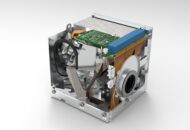Improvements in price/performance (and size) should create an increasing demand for new digital cameras some time.
Features other than (or in addition to)pictures will become important for the younger people; short video “clips” was one, audio appendages another and now the equivalent of a cassette or mini-disc recorder. Internet connection for downloading MP3 music is already available, admittedly constrained by the capacity of the storage cards, but that will improve very quickly. In this sense the new generation of digital camera is heading for serious competition with up market mobile phones, which already have low resolution picture capabilities. This is significant because to date both markets are dominated by different manufacturers (Sony, Kodak for cameras, Nokia, Motorola, etc. for mobiles) and to some extent different retail outlets. It surely won’t stay so separated.
There is also a market for “add-ons” for digital cameras. Batteries consumption is high, particularly if the user can’t resist the temptation to keep looking at the display; older camera users had to carry a supply of film, digital users carry batteries and storage cards! Spare storage cards are needed for any serious users, which creates a market for portable bulk storage devices.
What is clearly needed is a revamp of the film processing service industry to align with the digital era. The first phase in the digital camera era has been based on home processing, which has been fine for the PC enthusiast, but is a problem for the mass of users looking to replace film cameras. There are a few good software products, but not many; the bulk are far too complex. Products like Adobe’s PhotoShop are only for regular professional users and the cheaper PhotoShop Elements is a disgrace, being simply a subset of PhotoShop and not designed for the enthusiastic amateur, and certainly not for “snap camera” users. But if processing digital pictures on a PC is difficult, that is nothing compared to the problems (and expense) of printing. It is useful to be able to display images on a PC (I find JASC AfterShot excellent for this), but this is simply not a substitute for the traditional prints in a photo album, which is far more “user friendly”. It follows that the processing industry must resolve this problem.
The processors began by offering the option of creating a CD of JPEG images as well as prints from film. This enabled PC enthusiasts to display their pictures on a PC, but what for? If it is needed to further process a specific picture, to make a blow-up for instance, or to submit a picture for publication, then a high resolution scan is needed. This needs more specialised equipment such as a negative (not a flat-bed) scanner. The expensive digital cameras can produce an image equivalent to a high resolution scan, but none of this is the world of the mass of ordinary users. The solution then is obvious; the processors must set up a new service to produce prints from a CD. It should be possible to submit a camera memory card, but a better idea would be to download into the PC, where the better pictures can be isolated and processed (an instant fix and a crop would suffice most times), and the selected set burnt to a CD. Blank CDs are cheap and most people who haven’t already given up their digital cameras will have a sufficiently equipped PC.
If this shift takes place then film sales will fall, but sales of commercial printing materials will flourish. Will this be enough for Kodak and Fuji I wonder?< BR>
Martin Healey, pioneer development Intel-based computers en c/s-architecture. Director of a number of IT specialist companies and an Emeritus Professor of the University of Wales.





